Georges Guynemer Memorial, Poelkapelle
This memorial to Capitaine Georges Guynemer commemorates the French Air Ace and national hero, who was reported missing in action over this part of the Ypres Salient on 11 September 1917.
Georges Guynemer (1894-1917)
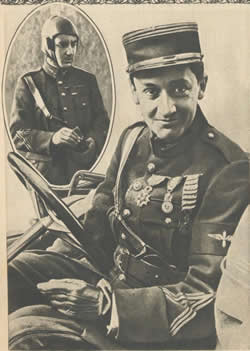
|
After the outbreak of war Georges Marie Ludovic Jules Guynemer tried to join the French Air Service (Aviation Militaire) but was rejected several times for health reasons. Having a very keen interest in aviation and a knowledge of the internal combustion engine through his friendship with the son of the Panhard Motor Company, he was very keen to get into the Air Service. He got an interview at the Military School of Aviation at Pau with the Commandant du Pilotage (Chief Pilot) Capitaine Alphonse Bernard-Thierry. Successful in the interview, Georges started training as a mechanic on 23 November 1914.
Georges was absolutely determined to become a pilot and eventually succeeded in being accepted for flight training. His first flight behind the controls was on 26 January 1915. In May 1915 he was appointed to the rank of corporal and on 8 June he joined French squadron Escadrille MS.3 based at Vauciennes near Villers-Cotterets. The commander of the squadron was Capitaine Brocard. The plane he was flying was a Morane-Saulnier L monoplane, which had been flown previously by the pilot Charles Bonnard. Bonnard had named this plane “Vieux Charles” (translates as Old Charles). Guynemer kept the name for this and most of the subsequent aircraft he flew.
In February 1916 the squadron's name was changed to Escadrille N.3. Guynemer was flying the new aeroplanes provided to the squadron, Nieuport 10 biplanes.
Guynemer was promoted to the rank of Second Lieutenant in April 1916. The Escadrille N.3 was moved to the Verdun battle sector where Guynemer was wounded.
In May 1916 Escadrille N.3 moved further north on the Western Front to the Somme battle sector. Joining with Escadrille Numbers 26, 103, 73 and 67 they formed a battle group called the “Groupe de Chasse des Cigognes”, which translates literally as the “Storks Chasing Group”. Escadrille N.3 took part in the Battle of the Somme for six months during the summer and autumn of 1916.
The Stork Insignia
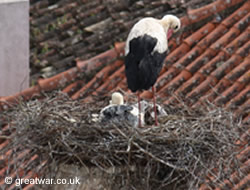
|
In May of 1916 the idea had been put forward to paint an easily recognisable symbol on the fuselage of each French aircraft in the Somme Battle Group so that the pilots could recognise other members of their own squadron in the air, especially when they had to regroup after a fight with the enemy.
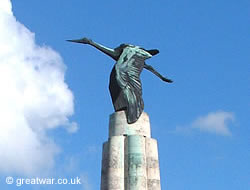
|
One suggestion was to have the French cockerel, a national and patriotic French symbol, painted on the aeroplanes. But it was the commander of the Battle Group, Capitaine Brocard, who suggested the image of a stork for the new insignia. The stork was a national symbol of the province of Alsace. These large, majestic birds have figured in everyday life in the region over the centuries, arriving each spring on their annual migration to build large nests on the gatehouses of walled villages and the roofs of half-timbered Alsatian houses. Alsace had been taken by Imperial Germany as a territorial prize after the defeat of France in the Franco-Prussian war of 1870-71.
When the First World War was declared in August 1914 Escadrille MS.3 (later renamed N.3) was in Belfort near the Franco-German 1914 border under the command of the French Army of Alsace. For the two years it had been there from late 1912 the flying machines of this squadron had already been likened to the symbolic annual arrival of the storks flying into Alsace. The squadron had flown in action during August 1914 and the early French encounters with the Seventh Imperial German Army at the Battle of Mulhouse and the Vosges mountains. The stork became a symbol for the French people of their great desire to liberate Alsace from German rule.
Capitaine Brocard's suggestion for the image of the stork for Escadrille N.3 was to be viewed from the side whilst in flight with its wings down. Escadrille N.3 became known as the “Cigognes” or “Storks Escadrille”. The link between the famous pilot Guynemer and the stork of Escadrille N.3's emblem meant that this particular stork badge became known as the “Guynemer Stork”.
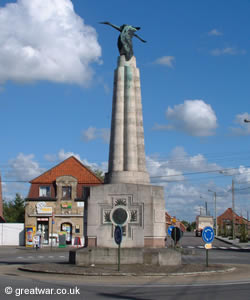
|
Capitaine Brocard suggested that the other squadrons should use the symbol of the stork also, but they would distinguish their emblems from one another by placing the bird's wings in different positions.
Modern French Air Force Stork Emblems
Today the French Air Force still carries the stork emblem on the three squadrons of the Groupe de Chasse 01.002 “Cigognes”.
The three modern fighter squadrons in this Groupe de Chasse are:
- SPA3 “Guynemer” displaying the low-winged stork emblem
- SPA103 “Fonck”, after the French Ace Capitaine René Fonck, displaying a high-winged stork emblem
- SPA12 displaying a stork emblem with outstretched wings.
1917
In February 1917 Georges Guynemer was promoted to the rank of Captain. Four months later, in June 1917, Escadrille N.3 was moved to the Chemin des Dames Aisne sector and then in mid July the squadron moved further north into Belgian Flanders to play a part in the Allied offensive during the Third Battle of Ypres.
Missing in Action
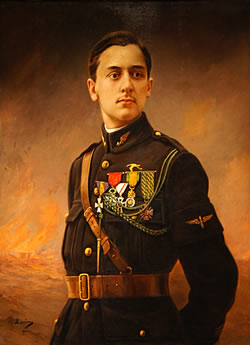
|
On the morning of 11 September 1917 Captain Georges Guynemer, commander of Escadrille N.3, took off in a Spad XIII. He did not return to the squadron airfield at Dunkirk, and was posted as missing in action in the vicinity of Poelkapelle.
The following extract is taken from a book about Guynemer, written in 1918 by Henry Bordeaux and translated by Louise Morgan Sill. It describes the events of the last hours of Georges Guynemer:
“III The Last Flight
On Tuesday, September 11, the weather was once more uncertain. But morning fogs by the seaside do not last, and the sun soon began to shine. Guynemer had had a restless night after his failures, and had brooded, as irritable people do, over the very things that made him fretful. Chasing without his new airplane—the enchanting machine which he had borne in his mind so many months, as a women bears her child, and which at last he had felt soaring under him—was no pleasure. He missed it so much that the feeling became an obsession, until he made up his mind to leave for Buc before the day was over. Indeed, he would have done so sooner had he not been haunted by the idea that he must first bring down his Boche. But since the Boche did not seem to be willing.... Now he is resolved, and more calm; he will go to Paris this very evening. He has only to while away the time till the train is due. The prospect in itself is quieting, and besides Major du Peuty, one of the chiefs of Aviation at Headquarters, and Major Brocard, recently appointed attaché to the Minister of Aëronautics, were coming down by the early train. They were sure to arrive at the camp between nine and ten, and a conversation with them could not but be instructive and illuminating; so, better wait for them.
But, in spite of these tranquillizing thoughts, Guynemer was restless, and his face showed the sallow color which always foreboded his physical relapses. His mind was not really made up, and he would come and go, strolling from his tent to the sheds and from the sheds to his tent. He was not cross, only nervous. Suddenly he went back to the shed and examined his Vieux-Charles. Why, the machine was not so bad after all; the motor and guns had been repaired, and yesterday's accident was not likely to happen again. If so, why not fly? In the absence of Heurtaux, Guynemer was in command, and once more the necessity of setting a good example forced itself upon him. Several flyers had started on scouting work already; the fog was quickly lifting, the day would soon be resplendent, and the notion of duty too quickly dazzled him, like the sun. For duty had always been his motive power; he had always anticipated it, from the day when he was fighting to enlist at Biarritz to this 11th of September, 1917. It was neither the passion for glory nor the craze to be an aviator which had caused him to join, but his longing to be of use; and in the same way his last flights were made in obedience to his will to serve.
All at once he was really resolved. Sous-lieutenant Bozon-Verduraz was requested to accompany him, and the mechanicians wheeled the machines out. One of his comrades asked with assumed negligence: “Aren't you going to wait till Major du Peuty and Major Brocard arrive?” Guynemer's only answer was to wave towards the sky then freeing itself from its veils of fog as he himself was shaking off his hesitancy, and his friend felt that he must not be urgent. Everybody of late had noticed his nervousness, and Guynemer knew it and resented it; tact was more necessary than ever with him. Let it be remembered that he was the pet, almost the spoiled child, of his service, and that it had never been easy to approach him.
Meanwhile, the two majors, who had been met at the station, were told of his nervous condition, and hurried to speak to him. They expected to reach the camp by nine o'clock, and would send for him at once. But Guynemer and Bozon-Verduraz had started at twenty-five minutes past eight.
They had left the sea behind them, flying south-east. They had reached the lines, following them over Bixchoote and the Korteker Tavern which the French troops had taken on July 31, over the Bixchoote-Langemarck road, and finally over Langemarck itself, captured by the British on August 16. Trenches, sections of broken roads, familiar to them from above, crossed and recrossed each other under them, and they descried to the north of Langemarck road the railway, or what used to be the railway, between Ypres and Thourout and the Saint-Julien-Poelkapelle road. No German patrol appeared above the French or British lines, which Guynemer and his companion lost sight of above the Maison Blanche, and they followed on to the German lines over the faint vestiges of Poelkapelle.
Guynemer's keen, long-practiced eye then saw a two-seated enemy airplane flying alone lower down than himself, and a signal was made to attract Bozon-Verduraz’ notice. A fight was certain, and this fight was the one which Fate had long decided on. The attack on a two-seater flying over its own lines, and consequently enjoying unrestricted freedom of movement, is known to be a ticklish affair, as the pilot can shoot through the propeller and the passenger in his turret rakes the whole field of vision with the exception of two angles, one in front, the other behind him under the fuselage and tail. Facing the enemy and shooting directly at him, whether upwards or downwards, was Guynemer's method; but it is not easy on account of the varying speeds of the two machines, and because the pilot as well as the passenger is sheltered by the engine. So it is best to get behind and a little lower than the tail of the enemy plane.
Guynemer had frequently used this maneuver, but he preferred a front attack, thinking that if he should fail he could easily resort to the other, either by turning or by a quick tail spin. So he tried to get between the sun and the enemy; but as ill-luck would have it, the sky clouded over, and Guynemer had to dive down to his opponent's level, so as to show him only the thin edges of the planes, hardly visible. But by this time the German had noticed him, and was endeavoring to get his range. Prudence advised zigzagging, for a cool-headed gunner has every chance of hitting a straight-flying airplane; the enemy ought to be made to shift his aim by quick tacking, and the attack should be made from above with a full volley, with the possibility of dodging back in case the enemy is not brought down at once. But Guynemer, regardless of rules and stratagems, merely fell on his enemy like a cannon ball. He might have said, like Alexander refusing to take advantage of the dark against Darius, that he did not want to steal victory. He only counted on his lightning-like manner of charging, which had won him so many victories, and on his marksmanship. But he missed the German, who proceeded to tail spin, and was missed again by Bozon-Verduraz, who awaited him below.
What ought Guynemer to do? Desist, no doubt. But, having been imprudent in his direct attack, he was imprudent again on his new tack, and his usual obstinacy, made worse by irritation, counseled him to a dangerous course. As he dived lower and lower in hopes of being able to wheel around and have another shot, Bozon-Verduraz spied a chain of eight German one-seaters above the British lines. It was agreed between him and his chief that on such occasions he should offer himself to the newcomers, allure, entice, and throw them off the track, giving Guynemer time to achieve his fifty-fourth success, after which he should fly round again to where the fight was going on. He had no anxiety about Guynemer, with whom he had frequently attacked enemy squadrons of five, six, or even ten or twelve one-seaters. The two-seater might, no doubt, be more dangerous, and Guynemer had recently seemed nervous and below par; but in a fight his presence of mind, infallibility of movement, and quickness of eye were sure to come back, and the two-seater could hardly escape its doom.
The last image imprinted on the eyes of Bozon-Verduraz was of Guynemer and the German both spinning down, Guynemer in search of a chance to shoot, the other hoping to be helped from down below. Then Bozon-Verduraz had flown in the direction of the eight one-seaters, and the group had fallen apart, chasing him. In time the eight machines became mere specks in the illimitable sky, and Bozon-Verduraz, seeing he had achieved his object, flew back to where his chief was no doubt waiting for him. But there was nobody in the empty space. Could it be that the German had escaped? With deadly anguish oppressing him, the airman descended nearer the ground to get a closer view. Down below there was nothing, no sign, none of the bustle which always follows the falling of an airplane. Feeling reassured, he climbed again and began to circle round and round, expecting his comrade. Guynemer was coming back, could not but come back, and the cause of his delay was probably the excitement of the chase. He was so reckless! Like Dorme—who one fine morning in May, on the Aisne, went out and was never heard of afterwards—he was not afraid of traveling long distances over enemy country. He must come back. It is impossible he should not come back; he was beyond the reach of common accidents, invincible, immortal! This was a certitude, the very faith of the Storks, a tenet which never was questioned. The notion of Guynemer falling to a German seemed hardly short of sacrilege.
So Bozon-Verduraz waited on, making up his mind to wait as long as necessary. But an hour passed, and nobody appeared. Then the airman broadened his circles and searched farther out, without, however, swerving from the rallying-point. He searched the air like Nisus the forest in his quest of Euryalus, and his mind began to misgive him.
After two hours he was still waiting, alone, noticing with dismay that his oil was running low. One more circle! How slack the engine sounded to him! One more circle! Now it was impossible to wait any more: he must go back alone.
On landing, his first word was to ask about Guynemer.
“Not back yet!”
Bozon-Verduraz knew it. He knew that Guynemer had been taken away from him.
The telephone and the wireless sent their appeals around, airplanes started on anxious cruises. Hour followed hour, and evening came, one of those late summer evenings during which the horizon wears the tints of flowers; the shadows deepened, and no news came of Guynemer. From neighboring camps French, British, or Belgian comrades arrived, anxious for news. Everywhere the latest birds had come home, and one hardly dared ask the airmen any question.
But the daily routine had to be dispatched, as if there were no mourning in the camp. All the young men there were used to death, and to sporting with it; they did not like to show their sorrow; but it was deep in them, sullen and fierce.
At dinner a heavy melancholy weighed upon them. Guynemer's seat was empty, and no one dreamed of taking it. One officer tried to dispel the cloud by suggesting hypotheses. Guynemer was lucky, had always been; probably he was alive, a prisoner.
Guynemer a prisoner!... He had said one day with a laugh, “The Boches will never get me alive,” but his laugh was terrible. No, Guynemer could not have been taken prisoner. Where was he, then?
On the squadron log, sous-lieutenant Bozon-Verduraz wrote that evening as follows:
Tuesday, September 11, 1917. Patrolled. Captain Guynemer started at 8.25 with sous-lieutenant Bozon-Verduraz. Found missing after an engagement with a biplane above Poelkapelle (Belgium).
That was all.” (3)
The German Account
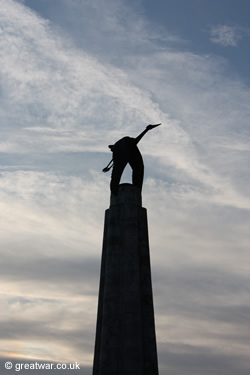
|
The German pilot Leutnant Kurt Wisseman of the Jasta 3 squadron is believed to have shot him down behind the German lines. Wisseman was himself shot down and killed 17 days later.
The disappearance of Guynemer and his machine was a considerable shock to the French people and they mourned for him. Stories that he had been found by the Germans and buried were told, but his aircraft did not appear on a list published by the German War Office of Allied planes that had been shot down behind German lines. By 9 October the British Army captured Poelkapelle after a bitter fight, but no marked burial place could be found.
On 8 November 1917 an official answer from the German Foreign Office to the Spanish Ambassador went as follows:
“Captain Guynemer fell in the course of an air fight on September 11 at ten a.m. close to the honor graveyard No. 2 south of Poelkapelle. A surgeon found that he had been shot through the head, and that the forefinger of his left hand had been shot off by a bullet. The body could neither be buried nor removed, as the place had been since the previous day under constant and heavy fire, and during the following days it was impossible to approach it. The sector authorities communicate that the shelling had plowed up the entire district, and that no trace could be found on September 12 of either the body or the machine. Fresh inquiries, which were made in order to answer the question of the Spanish Embassy, were also fruitless, as the place where Captain Guynemer fell is now in the possession of the British.
The German airmen express their regret at having been unable to render the last honors to a valiant enemy.
It should be added that investigation in this case was only made with the greatest difficulty, as the enemy was constantly attacking, fresh troops were frequently brought in or relieved, and eye witnesses had either been killed or wounded, or transferred. Our troops being continually engaged have not been in a position to give the aforesaid information sooner.” (4)
The Memorial at Poelkapelle
The sculpture of the “Guynemer Stork” on the memorial, with its wings down as in the stork emblem of Escadrille N.3, is flying in a north-easterly direction. Guynemer was last seen by Sous-Lieutenant Bozon-Verduraz flying in this direction before he went missing.
Awards
From his first victory bringing down his first enemy aircraft on 15 June 1915, and the subsequent award of the Médaille Militaire, Guynemer had a total of 53 confirmed “kills” attributed to him.
In December 1915 he had received an award of the highest gallantry decoration in France, the Legion of Honour. He was awarded the first level of this award, the Chevalier de la Légion d'Honneur (Knight of the Legion of Honour) for his valour. By this time he had 13 confirmed victories. In June 1917 he was awarded the next level up of the Legion of Honour award, the Officier de la Légion d'Honneur (Officer of the Legion of Honour). At that time he already had 45 confirmed “kills”.
Commemoration in Paris
Georges Guynemer is commemorated on a plaque in the Panthéon mausoleum in Paris, the location of commemoration and interrment of distinguished French citizens.
The plaque to Guynemer reads:
A LA MEMOIRE
CAPITAINE GUYNEMER
SYMBOLE DES ASPIRATIONS ET DES
ENTHOUSIASMES DE L'ARMEE DE LA NATION
Location of the Guynemer Memorial
Guynemerplein, 8920 Langemark-Poelkapelle, Belgium
Latitude N 50° 55' 3 " ; Longitude E 2° 57' 24"
Latitude 50.917618; Longitude 2.956537
The Georges Guynemer Memorial is located on the roundabout at the west end of Poelkapelle village, at the junction of the N313 and N301. There is parking on the street and outside a row of houses nearby in Guynemerplein. Visitors are reminded to take great care if stopping to take photographs as it can be a busy junction at certain times of the day.
T'Oud Gemeentehuis Tea Room and B&B
Located close to the memorial is a Tea Room, a good place for visitors to stop and eat while out on the battlefields. Visit the website for opening hours and menus.
Website: www.guesthouse-poelkapelle.be
Useful Link
French Military Aviation
This website (in French) contains a superb amount of research, information, photographs, and maps compiled by Denis Albin.
Website: albindenis.free.fr/Site_escadrille/page_centaine.htm
Further Reading
Georges Guynemer, Knight of the Air: Project Gutenberg EBook. This book by Henry Bordeaux, first published in 1918, has been translated from the French by Louise Morgan Sill and is available to download for free under the terms of Project Gutenberg. The book gives lots of detail about Guynemer's character and the events he experienced during his time as a pilot with Escadrille N.3.
Under the terms of use and reference to this work the following text applies. For more information about the project and this book visit the link to the website in the following text:
This eBook is for the use of anyone anywhere at no cost and with almost no restrictions whatsoever. You may copy it, give it away or re-use it under the terms of the Project Gutenberg License included with this eBook or online at www.gutenberg.org.
Download the EBook at: www.gutenberg.org/ebooks/18117

The Storks: The Story of the Les Cigognes, France's Elite Fighter Group of WW1 (hardcover)
by Norman L R Franks, Frank Bailey and Greg van Wyndgarden (Illustrator)
224 pages. Published by Grub Street (31 May 1998), ISBN-10: 1898697817 and ISBN-13: 978-1898697817
Acknowledgements
Website by Denis Albin about French Military Aviation: http://albindenis.free.fr/Site_escadrille/page_centaine.htm
L'Armée de l'Air (French Air Force) website: http://www.defense.gouv.fr/air/activites/unites-aeriennes/escadrons-de-chasse/escadron-de-chasse-01.002-cigognes
Website www.theaerodrome.com
(1) Photo of Georges Guynemer courtesy of Wikimedia Commons, source Lectures pour tous, 1 July 1917: http://en.wikipedia.org/wiki/File:Georges_Guynemer_1917.jpg
(2) Painting of Georges Guynemer courtesy of Wikimedia Commons by “Lucien” (unknown painter), Musée de la Légion d'Honneur et des Ordres de Chevalerie, Paris: http://en.wikipedia.org/wiki/File:Georges_guynemer_par_lucien.jpg
(3) Georges Guynemer, Knight of the Air: Project Gutenberg EBook. (This eBook is for the use of anyone anywhere at no cost and with almost no restrictions whatsoever. You may copy it, give it away or re-use it under the terms of the Project Gutenberg License included with this eBook or online at www.gutenberg.org.)
(4) Georges Guynemer, Knight of the Air: Project Gutenberg EBook. Footnote (3) refers.
